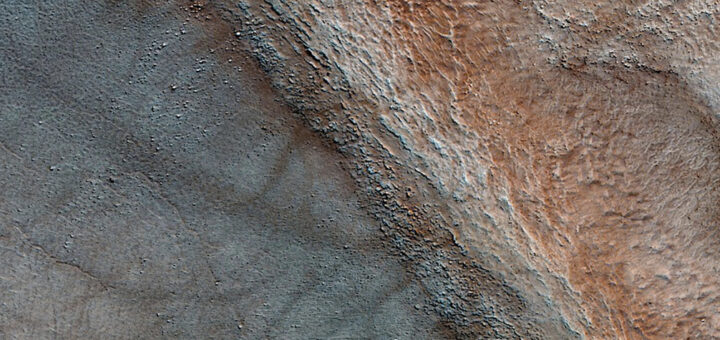Aliens on Mars: it’s more than just possible now

One step closer to meeting our new neighbours |
 Arroy (AJ) Jacob, Web Editor |
Arroy (AJ) Jacob, Web Editor |
The “red planet,” better known as Mars, has plagued astronomers, space engineers, and children with their father’s telescope alike with the same question: “Are there aliens on Mars?”
Now NASA says yes.
Not really. But NASA is coming forward with discoveries that hypothesize that Martians exist(ed) and are no longer the villain in a sci-fi horror blockbuster.
But the Martians NASA is referring to are not what movie lovers expect them to be. They don’t believe they have beady eyes, or giant heads, or numerous tentacles. Instead, researchers theorize them to be much more familiar to our world: they are microorganisms—which on paper sounds less interesting but, if proven true, would still be considered “aliens,” which is an excellent reframer.
Their existence came into public view with a recent publication in October 2024 of dusty ice existing within gullies on the Martian surface, a humble and resourceful ecosystem hidden beneath the red rock on Mars.
To fully understand the potential inhabitants of the red planet, it is important to fully explain the history and implications of our potential interplanetary neighbors living under the ice.
Did Mars once sustain life?
Approximately 4 billion years ago, Mars was thought to have looked and functioned as Earth does today. Oceans and land mass spanned and collided with wind and ice in a dance called evolution, forming a roughly habitable world that could have sustained life. This period in Mars’ history was known as the Noachian Period and was instrumental in establishing the elementary evidence that extraterrestrial life can exist.
And as all dances must come to an end, so did life on Mars, as the disappearance of its magnetic field had rendered the planet prone to the Sun’s radiation. Atmospheric escape had allowed the oceans to dry out and asteroids to destroy its surface, carving out numerous craters that likely rendered the planet sterile for over 2 billion years.
When the Mars Perseverance Rover landed on its surface in 2020, scientists had hoped to find any remnants of ancient life off the ruined rocks. Very briefly, it had appeared desolate, dry and lonely for Mr. Perseverance. Until 2021, from the NASA Jet Propulsion Laboratory, when Aditya Khuller and Phil Christensen had gotten a closer look at the rock and published their discovery of a potential home that would have harbored ancient microbial life—dusty ice in gullies.
Enter the dusty gullies
On Earth, gullies, rocks, and land physically morph into deep ravine channels due to erosion via consistent running water. These gullies can also house solid ice, which is crucial because it has a scientific characteristic essential to the Martian life theory.
“Dusty ice” refers to windblown particles that attach to ice blocks. When stuck, the particles absorb the sunlight and melt into the ice, seeping through and leaving holes across the ice surface known as “cryoconite” holes. The particles can stay dormant in the ice for generations, and during that time, its leftover heat leaves a still pocket of meltwater in the hole.
The conditions in these microscopic pockets are bountiful for microorganisms to grow, especially with liquid meltwater present, thus laying a foundational ecosystem for bacteria, fungi, algae, and other simple lifeforms to reproduce and colonize.
“This is a common phenomenon on Earth,” said Christensen in an interview with the NASA Jet Propulsion Laboratory.
If these tiny ecosystems are known to sustain millions of microorganisms on Earth, imagine Khuller and Christensen’s surprise to find similar cryoconite holes in the dusty ice gullies of Mars.
Photosynthesis is the cellular process between microorganisms that kickstarted all of natural, animal, and human evolution as we know it. And in October 2024, Khuller and Christensen co-authored a paper on how photosynthesis could be taking place under the Martian ice.
“If we’re trying to find life anywhere in the universe today, Martian ice exposures are probably one of the most accessible places we should be looking,” said Khuller in the same interview with NASA’s Jet Propulsion Laboratory.
Can microscopic Martians exist in these holes?
Khuller and Christensen say that it is possible. Their research emphasizes the potential for habitable zones for life within the Martian ice despite the planet’s harsh radiation environment. On Earth, sunlight penetrates several meters into ice, providing energy for organisms while shielding them from UV radiation. In contrast, Mars receives more harmful UV radiation due to its lack of an ozone layer.
However, the researchers’ models indicate that habitable zones could still exist within Martian ice, depending on the ice dust content it stuck to, a few centimeters to meters below the surface. Their statistical models predicted that there is a possibility of small amounts of liquid water present beneath the dense surface of dusty snow.
If proven true, they will enormously enhance the probability of microorganisms growing under the ice as we know it (or have once before).
As Khuller and Christensen summarized in their interview, these locations are the first on the list of places to find aliens.
Despite our yearnings, further research is required as it is difficult to pinpoint any conclusions that aliens exist on Mars without any physical analyses.
For now though, we can keep looking through our fathers’ telescopes, hoping that one day, our question will be answered.
Arroy (AJ) Jacob is the Web Editor for The Reflector 2024-2025. He is majoring in Cellular & Molecular Biology, and minoring in Creative Writing at Mount Royal University. He hopes to continue making scientific breakthroughs accessible, inclusive, and entertaining.




